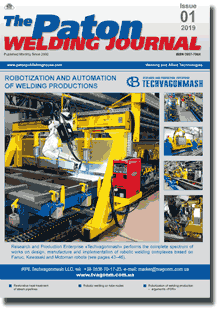| 2019 №01 (03) |
DOI of Article 10.15407/tpwj2019.01.04 |
2019 №01 (05) |

The Paton Welding Journal, 2019, #1, 15-24 pages
Journal The Paton Welding Journal
Publisher International Association «Welding»
ISSN 0957-798X (print)
Issue #1, 2019 (February)
Pages 15-24
Dependence of hygroscopicity of coatings of low-hydrogen electrodes on composition and structure of liquid glass
A.E. Marchenko1, V.V. Trachevsky2 and N.V. Skorina1
1E.O. Paton Electric Welding Institute of the NAS of Ukraine 11 Kazimir Malevich Str., 03150, Kyiv, Ukraine. E-mail: office@paton.kiev.ua
2Technical Center of the NAS of Ukraine 13 Pokrovskaya Str., 04070 Kyiv, Ukraine. E-mail:tracev@imp.kiev.ua
Presented were the results of investigation of hygroscopicity of coatings of low-hydrogen electrodes depending on composition of liquid Li-, Na- and K-glasses as well as their binary mixtures, which were interpreted from point of view of evolution of a silicon-oxygen structure in the process of glass formation under effect of changing type and relationship of cations of alkali metals. Carried diagnostics of structure-functional self-organization of the silicon-oxygen anions in composition of the liquid glasses was performed based on data of a nuclear magnetic resonance. The spectra of nuclear magnetic resonance 29Si were used. Generalized data were considered taking into account dominance of polycondensation mechanism. Correlation between the indices of coating hygroscopicity and relationship of bridge Q4, Q3, Q2 and nonbridge Q1 connectivities in structure of the silicon-oxygen anions were determined. 19 Ref., 2 Tables, 12 Figures.
Keywords: arc welding, welding electrodes, coating hygroscopicity, production technology, liquid glass, structure of liquid metal, spectroscopy of nuclear magnetic resonance
Received: 30.10.18
Published: 13.02.19
References
1. Smith, R. (1987) Improved consumables can change shopfloor practice. Met. Construct., 19(5), 282–283.
2. Barbin, L.M. (1977) The new moisture resistance electrodes. Weld. J., 56(7), 15–19.
3. (1983) LMA-a new quality concept for low hydrogen electrodes with low moisture absorption. Svetsaren (A Welding Review), 2, 3–5.
6. Becker, H. von (1964) Über die Feuchtigkeitsaufnahme, die Auswirkung und die Zweckmässige Rücktrocknung bei Schweisselektroden. Oerlikon Schweissmitteilungen, 22(52), 12–19.
7. Marshal, F.W., Farrar, J.C.M. (1983) Progress in moisture/hydrogen control of lime-fluorspar and lime-titania electrodes. In: Proc. of 1st Int. Conf. on Developments and Innovations for Improved Welding Production (13–15 Sept. 1983, Abington). London, 28, 1–10.
8. Kaljee, J. (1978) Hydrogen in weld metal; causes and remedies. Welding Reporter, 14(2), 5–10.
9. Kaljee, J. (1986) Moisture resistant electrode coating. FWP J., 26(1), 29, 30, 32–34, 38–40.
10. Marchenko, A.E., Skorina, N.V. (1989) Combined alkali silicates in manufacture of low-hydrogen electrodes. Metallurgical and technological problems of basic covered electrodes. In: Proc. of 2nd Int. School for Countries-Members of CMEA (Sofia, 1989). Kiev, Naukova Dumka, 123–130.
11. (2004) New electrodes for welding of carbon and low-alloy steels, demand and supply (in cooperation with I.R. Yavdoshchin et al.). In: Proc. of 3rd Int. Conf. of CIS Countries on Welding Consumables. Development. Technologies. Manufacture. Quality (Dnepropetrovsk, 1–-4 June 2004). Dnepropetrovsk, 64–67.
12. Hirai, Y., Minakawa, S., Tsuboi, J. (1980) Prediction of diffusible hydrogen content in deposited metal with basic type covered electrodes. IIW Doc. II-929–80.
13. ISO 14372:2000 (E): Welding consumables — Determination of moisture resistance of manual metal arc welding electrodes by measurement of diffusible hydrogen.
14. Marchenko, A.E., Skorina, N.V. (1981) Synergism of toughness of combined liquid glasses and properties of electrode compounds. CMEA: Inform. Materialy, 20(2), 109–115 [in Russian].
15. Marchenko, A.E., Skorina, N.V. (1987) Water-retaining ability of alkali silicates and its effect on dehydration of electrode coatings. Ibid., 31(1), 43–60 [in Russian].
16. Schleyer, W.L. (1970) Welding electrodes and the properties of soluble silicates. Weld. J., 49(12), 918–924.
17. Marchenko, A.E., Skorina, N.V., Kiselev, M.O., Trachevsky, V.V. (2017) Nuclear magnetic spectroscopy study of the structure of liquid glasses for welding electrodes. The Paton Welding J., 1, 41-45. https://doi.org/10.15407/tpwj2017.01.07
18. Anfilogov, V.N., Bykov, V.N., Osipov, F.F. (2005) Silicate melts. Moscow, Nauka [in Russian].
19. Dent Glasser, L.S., Lee, C.K. (1971) Drying of sodium silicate solution. J. of Appl. Chemical Biotechnology, 21(5), 127–133. https://doi.org/10.1002/jctb.5020210502
